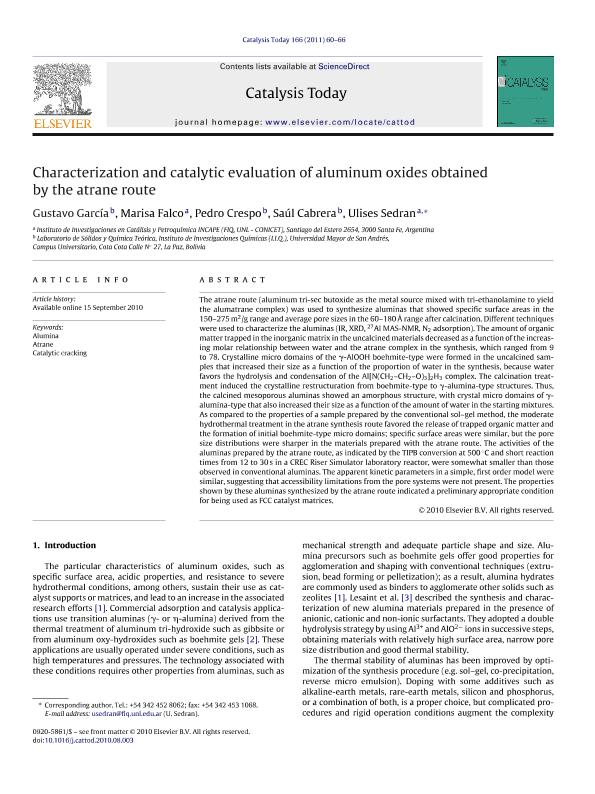Artículo
Characterization and catalytic evaluation of aluminum oxides obtained by the atrane route
Fecha de publicación:
05/2011
Editorial:
Elsevier Science
Revista:
Catalysis Today
ISSN:
0920-5861
Idioma:
Inglés
Tipo de recurso:
Artículo publicado
Clasificación temática:
Resumen
The atrane route (aluminum tri-sec butoxide as the metal source mixed with tri-ethanolamine to yield the alumatrane complex) was used to synthesize aluminas that showed specific surface areas in the 150-275 m2/g range and average pore sizes in the 60-180 range after calcination. Different techniques were used to characterize the aluminas (IR, XRD, 27Al MAS-NMR, N2 adsorption). The amount of organic matter trapped in the inorganic matrix in the uncalcined materials decreased as a function of the increasing molar relationship between water and the atrane complex in the synthesis, which ranged from 9 to 78. Crystalline micro domains of the γ-AlOOH boehmite-type were formed in the uncalcined samples that increased their size as a function of the proportion of water in the synthesis, because water favors the hydrolysis and condensation of the Al[N(CH2-CH 2-O)3]2H3 complex. The calcination treatment induced the crystalline restructuration from boehmite-type to γ-alumina-type structures. Thus, the calcined mesoporous aluminas showed an amorphous structure, with crystal micro domains of γ-alumina-type that also increased their size as a function of the amount of water in the starting mixtures. As compared to the properties of a sample prepared by the conventional sol-gel method, the moderate hydrothermal treatment in the atrane synthesis route favored the release of trapped organic matter and the formation of initial boehmite-type micro domains; specific surface areas were similar, but the pore size distributions were sharper in the materials prepared with the atrane route. The activities of the aluminas prepared by the atrane route, as indicated by the TIPB conversion at 500 °C and short reaction times from 12 to 30 s in a CREC Riser Simulator laboratory reactor, were somewhat smaller than those observed in conventional aluminas. The apparent kinetic parameters in a simple, first order model were similar, suggesting that accessibility limitations from the pore systems were not present. The properties shown by these aluminas synthesized by the atrane route indicated a preliminary appropriate condition for being used as FCC catalyst matrices.
Palabras clave:
Alumina
,
Atrane
,
Catalytic Cracking
Archivos asociados
Licencia
Identificadores
Colecciones
Articulos(INCAPE)
Articulos de INST.DE INVEST.EN CATALISIS Y PETROQUIMICA "ING. JOSE MIGUEL PARERA"
Articulos de INST.DE INVEST.EN CATALISIS Y PETROQUIMICA "ING. JOSE MIGUEL PARERA"
Citación
García, Gustavo; Falco, Marisa Guadalupe; Crespo, Pedro; Cabrera, Saúl; Sedran, Ulises Anselmo; Characterization and catalytic evaluation of aluminum oxides obtained by the atrane route; Elsevier Science; Catalysis Today; 166; 1; 5-2011; 60-66
Compartir
Altmétricas




